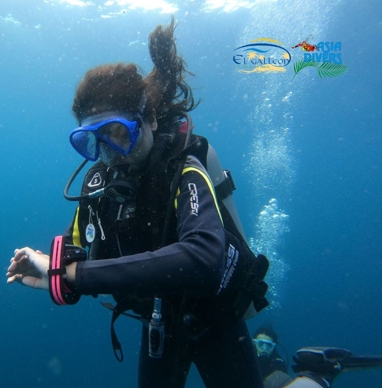At a particularly moonless and cloudy night, the pitch-black sky blends with the featureless blackwater diving site – just a short boat trip away from Puerto Galera. In the seemingly endless abyss, a magical scene emerges as your vision becomes accustomed to the dark. Small floaters and ghostly swimmers surround you, some translucent and bizarre-looking, but all worthy of a great series of photos.
Here are four tips to improve your blackwater photography so that you can make full use of the unique blackwater environment.
1. Master buoyancy
If you haven’t mastered neutral buoyancy, underwater photography at any time of day can be a great challenge. In blackwater, it gets harder because your camera works in a light-poor environment, even if you use flashlight and strobes. Any movement is sensitive and the camera demands that you stay still for a dozen seconds at a time.
Another advantage of peak-performance buoyancy is that easily-startled critters would feel less anxious in front of you as you don’t make so much movement. Smaller critters would not be pushed away by agitated water, which often happens when a diver moves too much.
2. Know your camera’s lighting needs
On land, try to experiment with macro shots at a shallower depth of field. A general rule of thumb for underwater photography is to get closer to the subject, instead of zooming.
If you take the shot at a distance while zooming, what happens is that there will be too little light for the camera to be able to focus perfectly, not to mention light scattering as your camera takes in more detail than it needs.
Some cameras require even more light at a minimum focal distance, so be sure to know how much light your camera requires.
3. Mind your light
Your lights have three functions: to help the camera focus, to help you find critters, and sometimes to attract critters to you.
The amount of light and exposure can also be affected by the type of light focus you choose – floodlight or spot. Spotlighting can be beneficial not only to find critters in the distance but also to provide a higher amount of light over a concentrated area. This is useful to photograph translucent critters as some absorb light.
It’s also important to not disturb light-sensitive nocturnal animals with spotlighting. Floodlights are a better choice to work with for easy-to-shoot critters.
4. Have patience and keep track of time
Many people get the hang of night photography in just a couple of hours on land. On your first few blackwater dives, you may only get a few good shots. While it is tempting to stay longer underwater to maximize your practice time, please remember the safety protocols of scuba diving and return to the surface at the right time.
Be patient, and keep practicing. Blackwater photography is a rare skill that takes years to fully master.
Dive with us!
At Asia Divers, our active community of blackwater divers is known to be very friendly and helpful. Don’t hesitate to contact us and become part of this great community.










